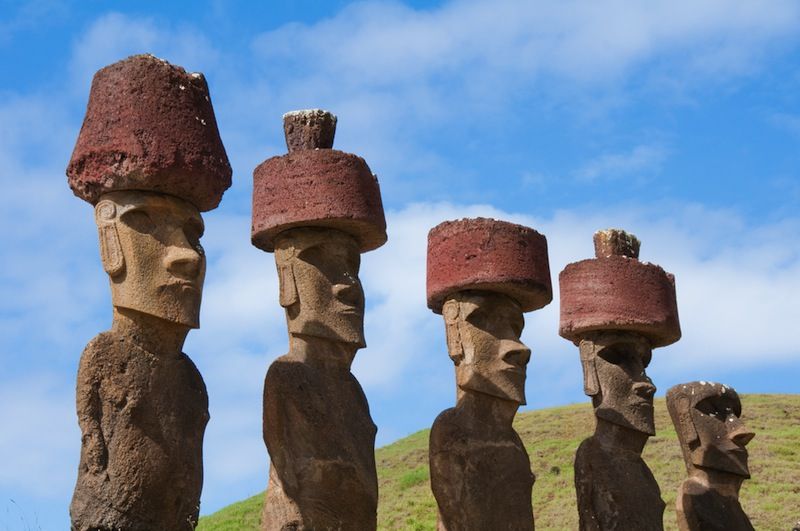
SAN FRANCISCO — The distinctive headgear worn by some of the famous Easter Island statues may have been rolled up ramps to reach those high perches, a new study suggests.
A simple analysis of the physics suggests that rolling the headwear — bulky cylindrical shapes that look like Russian fur hats — would have been a relatively easy matter, said study co-author Sean Hixon, an undergraduate student in archaeology and geology at the University of Oregon, who presented his findings here on April 16 at the 80th Annual Meeting of the Society for American Archaeology.
"It seems like a relatively small number of people could have done it, either by levering or rolling," Hixon said. [Image Gallery: Walking Easter Island Statues]
In addition, other features, such as indentations at the bases of the hats, line up with the rolling theory of placement, Hixon said.
Easter Island hats
Since Europeans arrived at the location in the 1700s, people have wondered how the residents of Easter Island, or Rapa Nui, off the coast of Chile, raised their majestic statues. Some scientists have speculated that the statues were walked into place. Others have argued that the native islanders chopped down the island's forests to roll the stone behemoths across the landscape, leading to environmental devastation and the collapse of the Easter Island civilization.
Some of these Easter Island statues, or moai, are topped by large red headgear. About 100 of these "hats," made from red volcanic rock called scoria, have been found, with many strewn along ancient paths on the island.
Sign up for the Live Science daily newsletter now
Get the world’s most fascinating discoveries delivered straight to your inbox.
Historians and ethnographers proposed that these "hats" were everything from feathered diadems, to turbans, to wigs, to elaborate hairdos. Nowadays, most scholars think the ornaments were meant to represent hair, and the Rapa Nui word for them, "pukao," means topknot, Hixon said. The pukaos for the biggest statues could be roughly 6.5 feet (2 meters) in diameter and weigh 12 tons, he added.
No one knows exactly what the hats signified, though their red color suggests they may have had a ritual significance, Hixon said. Because the hats were carved separately, archaeologists have questioned how people got the ornaments atop the moai, as the biggest of the statues could weigh 75 tons and stand a staggering 40 feet (12 meters) high.
Rolling, rolling, rolling
Hixon and his colleagues used simple physics to model the force and torque required to place the pukao atop the moai via different techniques, such as rolling the objects up a ramp to the top of the statues, building a giant tower and using a pulley system, or erecting the pukao and moai simultaneously.
The mostly oblong cross-section of the pukao meant that rolling up a ramp would have taken relatively little energy, and could have been done with fewer than 10 people, Hixon found. The oblong shape would have an advantage over a circular cross-section: it would prevent the pukao from rolling down the ramp by accident, HIxon said.
In addition, many of the statues have a small lip at the base. These indentations are about 0.78 inches (2 centimeters) thick, and "they pretty much fit the heads of the moai," Hixon told Live Science.
"The base indentation isn't really necessary for the hat once it's on the statue. The hats are pretty massive. It's not like they're going to fall off without the base indentation," Hixon said. Instead, these indentations might have helped prevent the pukao from tipping over during placement, if the statues themselves happened to tilt forward a bit, Hixon said.
Many of the pukao also exhibit ring-shaped indentations and vertical scratches around the sides, which could have provided traction as the headgear was rolled up a ramp, Hixon said.
Still, the research is far from definitive. Any of the proposed methods for raising the hats are theoretically possible with enough people, Hixon said. And erosion and damage have altered the sides of the pukaos, so it's difficult to determine whether the scratches on the outer surface were deliberately placed, Hixon said.
Follow Tia Ghose on Twitterand Google+. Follow Live Science @livescience, Facebook & Google+. Originally published on Live Science.

Tia is the managing editor and was previously a senior writer for Live Science. Her work has appeared in Scientific American, Wired.com and other outlets. She holds a master's degree in bioengineering from the University of Washington, a graduate certificate in science writing from UC Santa Cruz and a bachelor's degree in mechanical engineering from the University of Texas at Austin. Tia was part of a team at the Milwaukee Journal Sentinel that published the Empty Cradles series on preterm births, which won multiple awards, including the 2012 Casey Medal for Meritorious Journalism.